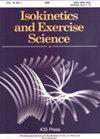非弹性绑带对动态膝外翻受试者下蹲时下肢运动学的影响
IF 0.7
4区 医学
Q4 ENGINEERING, BIOMEDICAL
引用次数: 0
摘要
背景:控制髋关节和踝关节的运动对动态膝外翻(DKV)患者非常重要,但很少有研究使用非弹性绑带(NET)来调整 DKV 患者在高抬腿深蹲(OHS)时髋关节和踝关节的对齐情况。目的:我们研究了在 OHS 期间对髋关节和踝关节应用非弹性绑带后下肢关节运动学和动态平衡的变化。方法:共有 30 名 DKV 患者参与了这项研究。我们测定了髋关节、膝关节和踝关节的运动学特性,以及 OHS 期间在三种条件下(未绑带、髋关节和踝关节上绑带 NET 以及假绑带)进行的下四分位 Y 平衡测试(YBT-LQ)的得分。结果:髋关节内旋、膝关节外翻和踝关节背屈角度在 NET 下明显低于未绑带或假绑带。敷贴 NET 后,髋关节屈曲角度和 YBT-LQ 得分明显高于未敷贴或假敷贴。结论:在进行 OHS 时应用 NET 是纠正 DKV 患者下肢对齐的有效方法,但应考虑在踝关节上应用 NET。本文章由计算机程序翻译,如有差异,请以英文原文为准。
Effects of non-elastic taping on the kinematics of the lower extremities during overhead squat in subjects with dynamic knee valgus
BACKGROUD: The control of hip and ankle joint movement is important for patients with dynamic knee valgus (DKV), but few studies have used non-elastic taping (NET) to adjust alignment of the hip and ankle joints during overhead squat (OHS) simultaneously in patients with DKV. OBJECTIVE: We investigated changes in lower extremity joint kinematics and dynamic balance after the application of NET to the hip and ankle joints during OHS. METHODS: A total of 30 DKV patients participated in this study. We determined the kinematics of the hip, knee, and ankle joints, and scores on the lower quarter Y-balance test (YBT-LQ) during OHS under three conditions (non-taping, NET on hip and ankle, and sham taping). RESULTS: Hip internal rotation, knee valgus, and the ankle dorsiflexion angle were significantly lower with NET than with non- or sham taping. The hip flexion angle and scores on the YBT-LQ were significantly greater with NET than with non- or sham taping. CONCLUSIONS: The application of NET while performing a OHS is a useful method for correcting lower extremity alignment in patients with DKV, however, application of NET on the ankle should be considered.
求助全文
通过发布文献求助,成功后即可免费获取论文全文。
去求助
来源期刊

Isokinetics and Exercise Science
医学-工程:生物医学
CiteScore
1.20
自引率
14.30%
发文量
37
审稿时长
>12 weeks
期刊介绍:
Isokinetics and Exercise Science (IES) is an international journal devoted to the study of theoretical and applied aspects of human muscle performance. Since isokinetic dynamometry constitutes the major tool in this area, the journal takes a particular interest in exploring the considerable potential of this technology.
IES publishes studies associated with the methodology of muscle performance especially with respect to the issues of reproducibility and validity of testing, description of normal and pathological mechanical parameters which are derivable from muscle testing, applications in basic research topics such as motor learning paradigms and electromyography. The journal also publishes studies on applications in clinical settings and technical aspects of the various measurement systems employed in human muscle performance research.
The journal welcomes submissions in the form of research papers, reviews, case studies and technical reports from professionals in the fields of sports medicine, orthopaedic and neurological rehabilitation and exercise physiology.
 求助内容:
求助内容: 应助结果提醒方式:
应助结果提醒方式:


